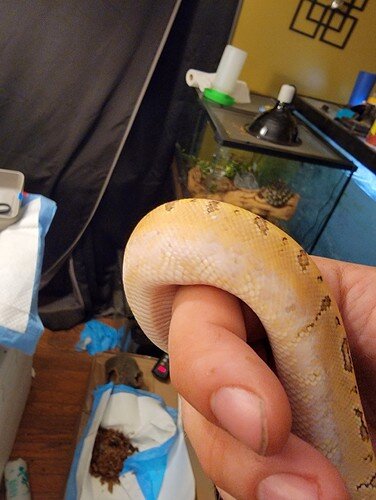Hey all, im sure all you longtime keepers are well acquainted with how to look for snake mites and how to deal with them should they hide through quarantine, however, for the newer keepers (and myself) im posting a PSA for just how hard to ID mites can be. I recently found a snake in my collection whos eyes were very sunken. They are usually hiding, and with me being on the road for work often, they hadnt gotten alot of handle time in the past couple months. Well, i couldnt find any mites in the substrate, and he isnt the fondest of me putting my face near him, so i figured perhaps it was dehydration.
Just to be safe, i looked through the rest of my collection and found a couple others with minor sinking in the eyes, but again, saw no mites, so figured my husbandry was slacking due to being on the road. The guy who was bad went into a humid box, and the others got a fresh mist.
Fast forward to night time, i am checking on the guy i put in the humid box, no noticable difference. Well booplesnoot who always wants to come out sees me and starts climbing. I pull him out and out of curiosity i start to give him a very thorough look. With him i could put his head in my mouth and he wouldnt care, so i had no fear of being bit in the face. Well, low and behold, i notice a slightly raised scale, and when i look at just the right angle, a mite!
I start relooking at everything now that i know how small the buggers are and confirmed one of my carpets had at least 1 as well.
So, my weekend is about to be very busy, but instead of hiding my shame, i want to post some pictures so some of the newer keepers can see how easily these buggers can hide before they swell up from feeding on your snake.
I will post more pics throughout the weekend as i deal with this scourge so hopefully my bad fortune can help others in the future. Hopefully they catch it at the individual level, but i had no idea what i was looking for and thought mites would be far more obvious. Seeing them now, i can tell my search on new animals wasnt nearly thorough enough.
Any treatment recommendations im open to. Im getting ready to wipe the slate clean, change all substrate, spray everything, and treat all snakes, just to nuke the problem, but ill be doing some research for safeties sake first, to ensure i dont accidentally poison my snakes.
Isopods will be getting moved to a different room, fortunately i never switched anything to bioactive yet, so it will be easy to move them.
Please forgive the mess, the past 2 months have been hectic. Been getring sent all along the east coast to fix helicopters, while receiving alot of snakes, while upgrading the snake room, while doing full time college. I am at the perfect storm of busy…













